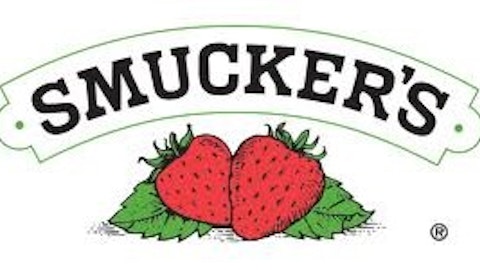It is a fact that China and India’s appetite for commodities over the last years has pushed up the prices of farm raw materials in a spectacular way. As a consequence, food prices have risen significantly which has benefitted the agrifood industry. As some costs keep on increasing and the American and European economies remain sluggish, agrifood companies will need to find ways to keep increasing sales and maintain their profit margins.
I will take a look at three major food producers in order to evaluate their performance.
Great expectations on emerging markets and new products
Through its most popular brands,General Mills, Inc. (NYSE:GIS) holds a significant market share in different growing food categories.
The company posted good results for its fourth quarter. Net sales reached $4.4 billion, increasing 8% year-over-year boosted by volume growth. However, changes in the business mix made underlying gross margins to decline from 37.2% to 34.8%. Overall, fiscal 2013 has been a good year for General Mills, Inc. (NYSE:GIS), with positive increases in net sales (7%), operating profits (6%) and net earnings (18%).
Management plans to enlarge the company’s position in the U.S. through innovation and diversification. Results support the company’s plans, since an extra $1 billion turnover over the past 20 months is explained by new product launches.
General Mills, Inc. (NYSE:GIS) is aiming to boost its international sales as well, focusing on Brazil, Russia, India and China. The turnover in China for fiscal 2013 will be $600 million, and it is expected to reach $900 million by 2015. Presence in India remains small still, but is growing: sales are forecasted to reach $70 million in fiscal 2013.
The company is poised to establish a stronger presence in international markets, and spent $898 million this fiscal year acquiring Yoki Alimentos (Brazil), Yoplait International, Parampara Foods (India), and Immaculate Baking (U.S.). Latin America is a key region for the company, as it will mean a raise of $1 billion in sales for fiscal 2013 through Yoki and will duplicate the preview year’s turnover.
In order to achieve projected earnings, however, the company must reduce its expenses. An ongoing ten-year program that started in 2010 aims to cut $3 billion in costs.
Buffet’s eye does not miss
The company has recently been acquired byBerkshire Hathaway Inc. (NYSE:BRK.A) (the Warren Buffett-led investment group) and 3G Capital Inc. for $28 billion. This shows that there is substantial value in this business. In fact, H.J. Heinz Company (NYSE:HNZ)’s most iconic product (its ketchup) posted a $5 billion turnover, an 8% year-on-year growth in fiscal 2012.
As we know, growing does not always mean top line growth. In order to gain productivity and reduce costs, H.J. Heinz Company (NYSE:HNZ) had to undertake major reforms. Figures speak for themselves: 11 factories were shut down, the workforce was reduced by 3,300 jobs, and inventory levels were brought down to 11%. These initiatives saved pre-tax costs for $224 million in fiscal 2012.
When it comes to the top line, H.J. Heinz Company (NYSE:HNZ) looks for geographical expansion. During the past ten years, sales outside of America climbed from 50% of total sales to nearly 70%. Despite Europe’s importance, the company is focusing on emerging markets, especially China, India, Indonesia, Eastern Europe, and Brazil. Management aims to double the turnover in these markets during the next three to five years, obtaining $5 billion in sales. H.J. Heinz Company (NYSE:HNZ) confirmed its strong interest in Brazil and China by adding local businesses Coniexpress and Foodstar Holding to the group.
A significant buyout and a larger presence abroad
The company reported earnings per share of only $0.99 for the first quarter of 2013, a 8.3% decline year-over-year. Revenue growth was also modest, growing 2.2% to $3.86 billion.
A key factor for Kellogg Company (NYSE:K) was the Pringles acquisition. This diversification should be extremely beneficial for the company as it turned Kellogg Company (NYSE:K) into a global snack player. The $1.5 billion buyout of Pringles will help lose dependency on its mainstay cereal business. Considering how solid Pringles is, it is an important decision and should help the company’s global position.
Since the cereal market in America has reached saturation levels and sales perspectives for Western Europe are not encouraging, the emerging markets became a key factor. Sales have tripled to $2 billion in Asia,
Central and Eastern Europe, Middle East, and Africa over the last decade and should keep on growing.
Kellogg Company (NYSE:K) has also been making investments in its supply chain infrastructure in order to cut costs. Since these initiatives finalized in 2011, we should now expect improvements in productivity in the range 3% or 4% per year.
Bottom line
General Mills, Inc. (NYSE:GIS) is showing a very special interest in the most important emerging markets, manifested by key acquisitions. The company is growing and if it manages to keep expenses down and continues to innovate it will certainly be worth investing in.
H.J. Heinz Company (NYSE:HNZ) past efforts to reduce costs and its new growth perspectives under Warren Buffet’s supervision makes me want to invest in the company.
The buyout of the Pringles brand makes a positive difference for Kellogg Company (NYSE:K)’s, diversifying away from the highly-competitive cereal category. We must understand that snacks are very competitive as well, however, so I would stay on the sidelines for this company’s stock for now.
The article 3 Food Champions to Analyze originally appeared on Fool.com and is written by Louie Grint.
Louie Grint has no position in any stocks mentioned. The Motley Fool recommends H.J. Heinz Company. Louie is a member of The Motley Fool Blog Network — entries represent the personal opinion of the blogger and are not formally edited.
Copyright © 1995 – 2013 The Motley Fool, LLC. All rights reserved. The Motley Fool has a disclosure policy.






